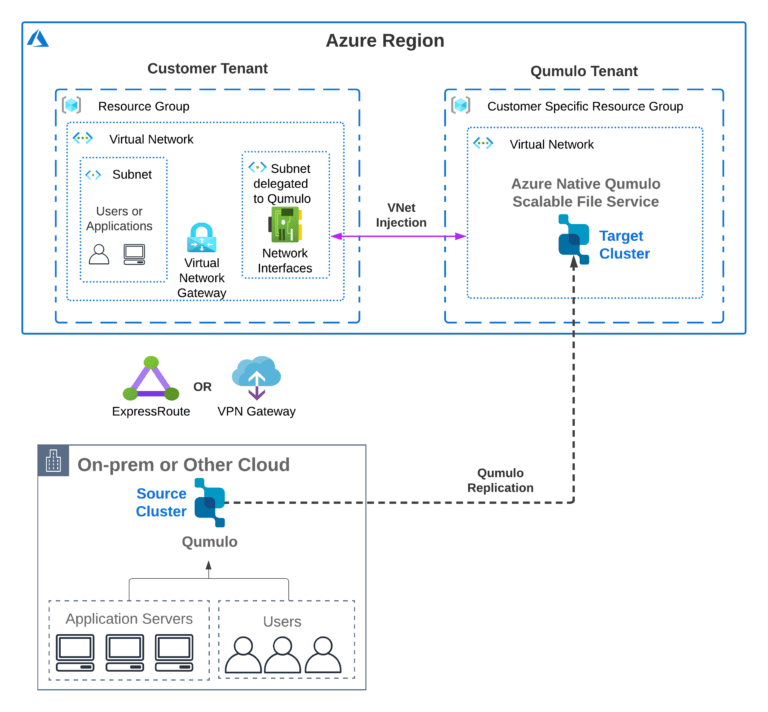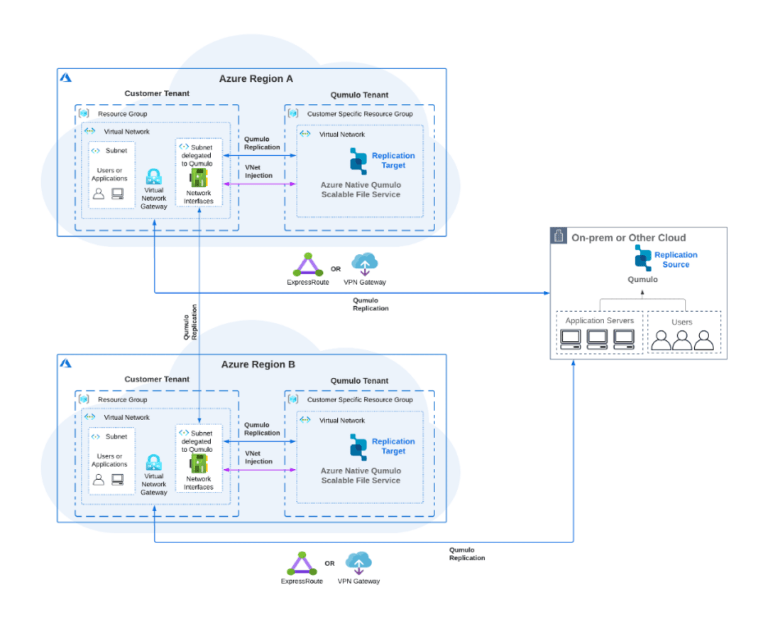Table of Contents
- Single Region Architecture
- Dual Region Architecture
- Components
- Potential uses cases
- Scalability and Performance
- Security
- Cost Optimization
- Availability
- Resilience
Deploy this Scenario
Contributors
Next steps
Related Resources
Disaster Recovery with Azure Native Qumulo Scalable File Service
This article describes the options for deploying a disaster recovery solution on Azure for unstructured data services using the Azure Native Qumulo Scalable File Service.
Architecture
Single Region Architecture

Download a Visio file of this architecture.
Azure Region to Azure Region

Download a Visio file of this architecture.
Dual Region Architecture

Components
- Azure Native Qumulo Scalable File Service
- Qumulo Continuous Replication
- Qumulo Snapshots with Replication
- Azure Virtual Network
- VNet Injection
- Azure ExpressRoute
- Azure VPN Gateway
- AD Domain Controllers, Applications, etc.
Scenario details
Potential use cases
This architecture applies to businesses that want to provide enterprise file services with multi-protocol access to unstructured data on a scalable architecture.
Potential use cases:
- Hybrid Cloud DR: Organizations can replicate their data to the cloud while also maintaining a secondary on-premises Qumulo cluster. In the event of a disaster, recovery can occur on either the cloud or the secondary on-premises cluster, depending on the circumstances of the event.
- Cloud-Based Replication: Maintaining a replicated copy of critical primary data on an Azure-based Qumulo cluster ensures that data remains available in the event of a disaster affecting the primary site. This approach allows for quick failover and minimal downtime during disaster recovery scenarios.
- Cloud Storage as Secondary DR Site: ANQ can be utilized as a secondary DR site, allowing organizations to replicate their data to the cloud in near real-time. In the event of a disaster impacting the primary on-premises site, organizations can switch to the replicated data on ANQ and continue operations with minimal disruption. Qumulo’s replication capabilities ensure data consistency and integrity during the failover process.
- Cloud-Based Backup and Restore: Organizations can back up their data from on-premises Qumulo clusters to an ANQ target, ensuring that a recent and secure copy of their data is available for recovery. In case of a disaster, organizations can restore the backed-up data from the cloud to a new or recovered ANQ cluster, minimizing data loss and downtime.
- Cloud-Based DR Testing and Validation: Organizations can replicate a subset of their data to an ANQ target and simulate disaster recovery scenarios to validate the effectiveness of their recovery procedures and integrity. This approach allows organizations to identify and address any potential gaps or issues in their DR plans without impacting their production environment.
- Cloud DR for Remote Offices/Branch Offices (ROBO): Organizations can deploy Qumulo clusters at their ROBO locations and replicate data to a centralized DR repository on an ANQ cluster. In the event of a disaster at any remote site, organizations can continue to support the impacted site from the ANQ instance until a new Qumulo cluster can be deployed at the affected site, ensuring business continuity and data availability.
Considerations
Organizations looking to plan and implement a Disaster-Recovery environment using Azure Native Qumulo Scalable File Service should include the following considerations in their planning and design processes.
Scalability and Performance
When planning an Azure Native Qumulo Scalable File Service deployment as a Disaster Recovery solution, organizations may want to factor any or all of the following into their initial capacity plans:
- The current amount of unstructured data within the scope of the failover plan
- If the solution is intended for use as a cloud-based backup and restore environment, the number of separate snapshots that the solution will be required to host, along with the expected rate of change within the primary dataset
- The throughput required to ensure that all changes to the primary dataset are replicated to the target ANQ cluster. When deploying ANQ, organizations can choose either the Standard or Premium performance tier, which offers higher throughput and lower latency for demanding workloads.
- Data replication occurs incrementally at the block level—after the initial synchronization is complete, only changed data blocks are replicated thereafter, which minimizes data transfer.
- In the event of a disaster scenario that requires failover to the ANQ cluster, the network connectivity and throughput are required to support all impacted clients for the duration of the outage event.
- Depending on the specific configuration, an ANQ cluster can support anywhere from 2GB/s-20GB/s max throughput and tens to hundreds of thousands of IOPS. Consult the Qumulo Sizing Tool for specific guidance on planning the initial size of an ANQ deployment.
Security
The Azure Native Qumulo Scalable File Service connects to your Azure environment using VNet injection, which is fully routable, inherently secure, and visible only to your resources. No IP space coordination between your environment and the ANQ cluster is required.
In an on-premises Qumulo cluster, all data is encrypted at rest using an AES 256-bit algorithm. ANQ leverages Azure’s built-in data encryption at the disk level. All replication traffic between source and target clusters is automatically encrypted in transit.
For information about third-party attestations Qumulo has achieved, including SOC 2 Type II and FIPS 140-2 Level 1, see Qumulo Compliance Posture in the Qumulo Core Administrator Guide.
Cost optimization
The cost of the solution depends on the amount of data being replicated, the rate of change, and the destination tier of the Azure Native Qumulo Scalable File Service. For details, see Azure Native Qumulo Scalable File Services pricing.
Availability
At the disk level, data redundancy in an ANQ deployment is automatically provided by Azure’s storage services. For data redundancy beyond the replication pairing of a primary Qumulo instance and an ANQ-based secondary cluster, replicating to a tertiary cluster in a second Azure region increases availability by protecting against regional service interruptions.
Resiliency
- Replicated directories on the secondary cluster are read-only.
- You have the capability to conduct an isolated disaster recovery test. It does not disrupt the production deployment.
Deploy this scenario
- For more information regarding the deployment of the Azure Native Qumulo Scalable File Service, see Getting Started with the Azure Native Qumulo Scalable File Service and Deployment
- For more information regarding the replication options on Qumulo, see Qumulo Continuous Replication and Qumulo Snapshot Policy Replication
- For more information regarding the failover/failback operations, see Using Failover with Replication in Qumulo
- For more information regarding the Qumulo solution, see QumuloSync For more information regarding the Required Networking Ports for Qumulo Core
Contributors
This article is maintained by Qumulo. It was originally written by the following contributors.
Principal authors:
Berat G. Ulualan | Solutions Architect at Qumulo
Next steps
Related resources
Azure Native Qumulo Scalable File Service (Marketplace)
Azure Native Qumulo Scalable File Service
Azure Native Qumulo Scalable File Service Guide
Qumulo Continuous Replication
Qumulo Snapshot Policy Replication
Using Failover with Replication in Qumulo
QumuloSync
Part I: Accelerate Data Recovery With Qumulo
Part II: Accelerate Data Recovery With Qumulo
Why Your Enterprise Infrastructure Should Innovate at the Speed of SaaS
Building a Hybrid Cloud File System for Radical Simplicity
